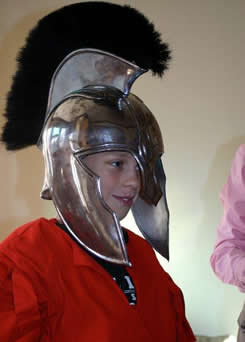

|
Western Civilizations Programs
|

It’s All Fun and Games:Historic Toys and Games
Yo-yo's, jump ropes, checkers, tops, jacks, and marbles provide opportunities to involve students in understanding how past civilizations impact the present. They also reveal ways in which humans adapt and assimilate ideas learned through migration and warfare. Beginning with ancient Egypt and moving towards Pennsylvania in the 21st century, we will discover ways in which technology and economics have affected playthings throughout history.
Wow, Naked Exercise: Influence of Ancient Greece on Early American Medicine
Can you envision sports practice without clothes? How about community bathing? This program will both amuse and surprise you. The ancient world’s revolutionary views on medicine heavily influenced medical treatments in early America. Modern medical symbols, use of the Hippocratic Oath, hygiene, sanitation, physical fitness, and medicinal plants all have ancient origins. Through material culture and activities, we will explore the role of the ancient world on Early America. You may conclude that you would have been safer to live in ancient Greece than colonial Pennsylvania.
Evergreens and Dreidels: American Holiday Customs
How did St. Nicholas, Christmas trees, gifts, vacation, carols, cookies, and a host of other traditions come to represent the season? The Saturnalia festivities of ancient Rome featured abundant and special foods, decorating with evergreens, singing, dancing, drinking, visiting, sacrifice, fortune telling, ceremony, and celebration. We will explore ways in which Roman customs were interpreted and converted in Europe and eventually adapted and blended by American religious and ethnic groups. This is not only the story of Christmas, but the evolution of Hanukkah in America.
The Making of Santa Claus: The Pennsylvania German Belsnickle
Each phase of Roman conquest brought divergent cultural groups together. Under the control of Rome, various Germanic sectors twisted Roman traditions to fit their cultural needs. German gift givers contained elements of Rome but were uniquely Germanic. Representing the good and the bad, Peltz Nichols and Christ kindles, Pelsnickles, and Knecht Rupperts dispensed goodies and beatings with equal fervor. Their nocturnal visits to households in December were expected with a mixture of anticipation and dread. As Germanic people flowed into Pennsylvania, the customs merged to become the Belsnickle. Through interaction with other cultural groups a new character emerged; he is known throughout the United States as Santa Claus.

